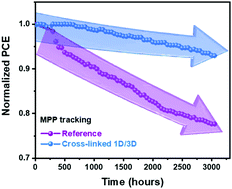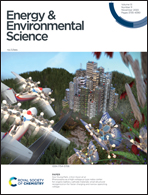An in situ cross-linked 1D/3D perovskite heterostructure improves the stability of hybrid perovskite solar cells for over 3000 h operation†
Abstract
Long-term stability is an essential requirement for perovskite solar cells (PSCs) to be commercially viable. Heterojunctions built by low-dimensional and three-dimensional perovskites (1D/3D or 2D/3D) help to improve the stability of PSCs. However, the insulated organic cations of low-dimensional perovskite impede the transport of carriers, decreasing the power conversion efficiency (PCE) of PSCs. Herein, we introduce an in situ cross-linking polymerizable propargylammonium (PA+) to the 3D perovskite film at surfaces and grain boundaries to form a 1D/3D perovskite heterostructure. This passivation strategy not only significantly improves the interfacial carrier transport but also releases residual tensile strain in perovskite films. As a result, the corresponding devices achieve a champion PCE of 21.19%, while maintaining 93% of their initial efficiency after 3055 h of continuous illumination under maximum power point (MPP) operating conditions.



 Please wait while we load your content...
Please wait while we load your content...